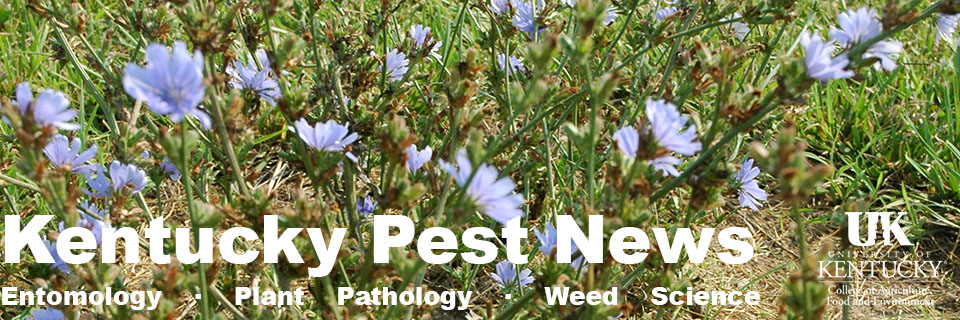Honey bees and other pollinators are as much a part of agriculture as cattle and corn. We hear a lot about protecting pollinators, as we should, since losses of honey bees since 2006 have been at unacceptable and unsustainable levels.…
Monthly Archives: May 2017
2017 Insect Trap Counts
Trap counts for major insect pests are provided by the Kentucky IPM Program. Traps are located at the UK Research and Education Center in western Kentucky and the UK Spindletop Farm in Lexington. Below are trap counts for the current…
Plant Disease Diagnostic Lab Highlights
The following plant disease highlights from the University of Kentucky Plant Disease Diagnostic Laboratories represent recent sample submissions from field crops, fruit, vegetables, and ornamentals. Recent diagnostic samples of agronomic crops have included zinc and magnesium deficiencies, seedcorn maggot injury…
Managing Aphids in High Tunnels and Greenhouses
One of the more common pest issues across a range of vegetable crops in greenhouses is aphid management. Vegetable production in protected environments is generally used to extend seasons and during these times of the year problems with aphids are…
Spruce Spider Mite Injury Appearing
Spruce spider mites (SSM), like other plant-feeding mites, use piercing-sucking mouthparts to feed on sap. Feeding from individual cells initially produces small, yellow splotches on needles. Over time, needles take on a dull, rusty appearance and some may drop prematurely. In…
Protect Yourself from Ticks
Ticks can make outdoor activities very uncomfortable, as well as pose a potential health threat (see Ticks and Disease in Kentucky EntFact 618). Tick season extends from mid-March through August across the Commonwealth. Important Kentucky Ticks Lone Star Tick Tick…
Dealing with Pesticide Spills
A spill is an accidental release of any amount of pesticide, small or large. Spills on public highways, such as when a tank on a truck overturns, usually have major consequences. Failure to respond quickly and appropriately to such mishaps…
Plant Disease Diagnostic Lab Highlights
The following plant disease highlights from the University of Kentucky Plant Disease Diagnostic Laboratories represent recent sample submissions from field crops, fruit, vegetables, and ornamentals. Recent diagnostic samples of agronomic crops have included Rhizoctonia crown rot on corn; target spot…
White Peach Scale
The white peach scale is increasingly more common as a pest of fruit and landscape trees. The waxy round coverings that protect overwintering females of this armored scale have orange to yellow centers that appear like tiny fired eggs. Scale…
Avoiding Pesticide Drift Is the Applicator’s Responsibility
Language and restrictions regarding pesticide drift vary among products, but all put the responsibility clearly with the applicator. One insecticide label states: Only apply this product if the wind direction favors on-target deposition. Do not apply when the wind velocity…
Spray Equipment Cleanup Saves Time and Money
Time spent in sprayer cleanup can reduce maintenance downtime and even cause costly crop injury. If you will be applying the same product the next day, then flushing the system with water may be sufficient. That will wash out accumulations…
Featured Publication
Managing Diseases of Herbaceous Ornamentals (PPFS-OR-H-01) Herbaceous landscape ornamentals can succumb to various adverse factors, including infectious and non-infectious diseases. Managing Diseases of Herbaceous Ornamentals provides suggestions for symptom recognition and management approaches to common problems of these crops in…
Plant Disease Diagnostic Lab Highlights
The following plant disease highlights from the University of Kentucky Plant Disease Diagnostic Laboratories represent recent sample submissions from field crops, fruit, vegetables, and ornamentals. Recent diagnostic samples of agronomic crops have included Lepto leaf spot on alfalfa; lance nematode…
2017 Insect Trap Counts
Trap counts for major insect pests are provided by the Kentucky IPM Program. Traps are located at the UK Research and Education Center in western Kentucky and the UK Spindletop Farm in Lexington. Below are trap counts for the current…
Fire Blight Symptoms Now Visible
Fire blight is the most important disease of apple and pear in Kentucky. Symptoms have begun to appear throughout the Commonwealth; however, initial infections occurred at bloom. The pathogen survives winter in dead, dying, and diseased wood and in cankers.…
